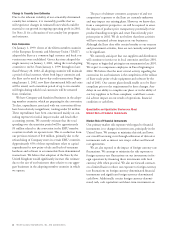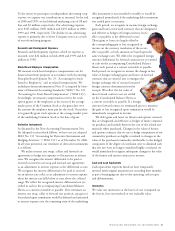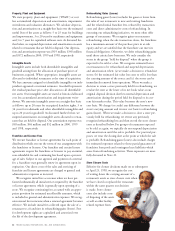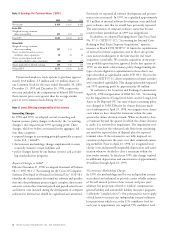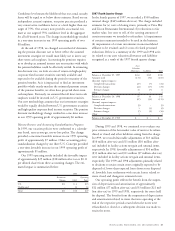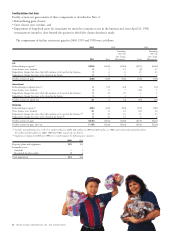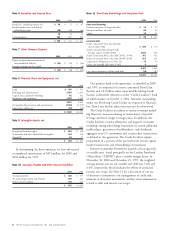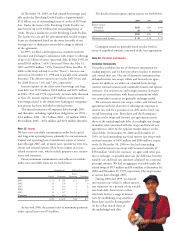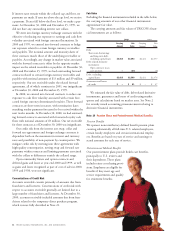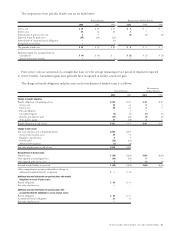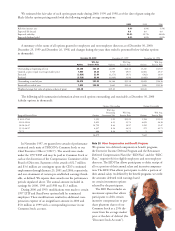Pizza Hut 2000 Annual Report Download - page 50
Download and view the complete annual report
Please find page 50 of the 2000 Pizza Hut annual report below. You can navigate through the pages in the report by either clicking on the pages listed below, or by using the keyword search tool below to find specific information within the annual report.
48 TRICON GLOBAL RESTAURANTS, INC. AND SUBSIDIARIES
Note 4 Earnings Per Common Share (“EPS”)
2000 1999 1998
Net income $«413 $«627 $«445
Basic EPS:
Weighted-average common
shares outstanding 147 153 153
Basic EPS $2.81 $4.09 $2.92
Diluted EPS:
Weighted-average common
shares outstanding 147 153 153
Shares assumed issued on exercise
of dilutive share equivalents 19 24 20
Shares assumed purchased with
proceeds of dilutive share equivalents (17) (17) (17)
Shares applicable to diluted earnings 149 160 156
Diluted EPS $2.77 $3.92 $2.84
Unexercised employee stock options to purchase approxi-
mately 10.8 million, 2.5 million and 1.0 million shares of
our Common Stock for the years ended December 30, 2000,
December 25, 1999 and December 26, 1998, respectively,
were not included in the computation of diluted EPS because
their exercise prices were greater than the average market
price of our Common Stock during the year.
Note 5 Items Affecting Comparability of Net Income
Accounting Changes
In 1998 and 1999, we adopted several accounting and
human resource policy changes (collectively, the “accounting
changes”) that impacted our 1999 operating profit. These
changes, which we believe are material in the aggregate, fall
into three categories:
• required changes in accounting principles generally accepted
in the U.S. (“GAAP”),
• discretionary methodology changes implemented to more
accurately measure certain liabilities and
• policy changes driven by our human resource and account-
ing standardization programs.
Required Changes in GAAP
Effective December 27, 1998, we adopted Statement of Position
98-1 (“SOP 98-1”), “Accounting for the Costs of Computer
Software Developed or Obtained for Internal Use.” SOP 98-1
identifies the characteristics of internal-use software and specifies
that once the preliminary project stage is complete, direct exter-
nal costs, certain direct internal payroll and payroll-related costs
and interest costs incurred during the development of computer
software for internal use should be capitalized and amortized.
Previously, we expensed all software development and procure-
ment costs as incurred. In 1999, we capitalized approximately
$13 million of internal software development costs and third
party software costs that we would have previously expensed.
The amortization of computer software assets that became
ready for their intended use in 1999 was insignificant.
In addition, we adopted Emerging Issues Task Force Issue
No. 97-11 (“EITF 97-11”), “Accounting for Internal Costs
Relating to Real Estate Property Acquisitions,” upon its
issuance in March 1998. EITF 97-11 limits the capitalization
of internal real estate acquisition costs to those site-specific
costs incurred subsequent to the time that the real estate
acquisition is probable. We consider acquisition of the prop-
erty probable upon final site approval. In the first quarter of
1999, we also made a discretionary policy change limiting the
types of costs eligible for capitalization to those direct cost
types described as capitalizable under SOP 98-1. Prior to the
adoption of EITF 97-11, all pre-acquisition real estate activities
were considered capitalizable. This change unfavorably impacted
our 1999 operating profit by approximately $3 million.
To conform to the Securities and Exchange Commission’s
April 23, 1998 interpretation of SFAS No. 121, “Accounting
for the Impairment of Long-Lived Assets and for Long-Lived
Assets to Be Disposed Of,” our store closure accounting policy
was changed in 1998. Effective for closure decisions made
on or subsequent to April 23, 1998, we recognize store closure
costs when we have closed the restaurant within the same
quarter the closure decision is made. When we decide to close
a restaurant beyond the quarter in which the closure decision
is made, it is reviewed for impairment. The impairment eval-
uation is based on the estimated cash flows from continuing
use until the expected date of disposal plus the expected
terminal value. If the restaurant is not fully impaired, we
continue to depreciate the assets over their estimated remain-
ing useful life. Prior to April 23, 1998, we recognized store
closure costs and generally suspended depreciation and amor-
tization when we decided to close a restaurant within the
next twelve months. In fiscal year 1999, this change resulted
in additional depreciation and amortization of approximately
$3 million through April 23, 1999.
Discretionary Methodology Changes
In 1999, the methodology used by our independent actuary
was refined and enhanced to provide a more reliable estimate
of the self-insured portion of our current and prior years’
ultimate loss projections related to workers’ compensation,
general liability and automobile liability insurance programs
(collectively “casualty loss(es)”). Our prior practice was to apply
a fixed factor to increase our independent actuary’s ultimate
loss projections which was at the 51% confidence level for
each year to approximate our targeted 75% confidence level.


